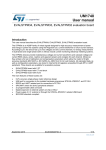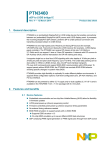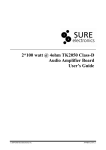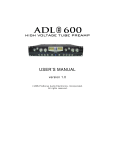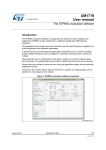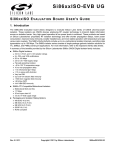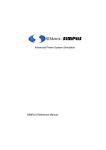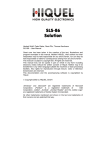Download EVALSTPM34, EVALSTPM33, EVALSTPM32 evaluation board
Transcript
UM1748 User manual EVALSTPM34, EVALSTPM33, EVALSTPM32 evaluation board Introduction This user manual describes the EVALSTPM34, EVALSTPM33, EVALSTPM32 evaluation board. The STPM3x is an ASSP family of mixed signals designed for high accuracy measurement of power and energy in power line systems using the Rogowski coil, current transformer or shunt current sensors. According to p/n, the device has up to two voltages and two current channels, for energy measurement in dual-phase and single-phase (with or without neutral current monitoring) electricity metering systems. The STPM3x devices provide instantaneous voltage and current waveforms and calculate voltage and current RMS values, active, reactive and apparent powers and energies for each channel. Moreover, they embed a full set of calibration and compensation parameters which allow the meter to fit tight accuracy standards (EN 50470-x, IEC 62053-2x, ANSI12.2x for AC watt meters). All calculated data, as well as configuration parameters, are stored in internal 32-bit registers accessible through SPI or UART peripheral. Three boards are available for evaluation purpose: • EVALSTPM34 board with 2 CT • EVALSTPM33 board with CT + shunt • EVALSTPM32 board with shunt The main features of these boards are: April 2014 • 0.2% accuracy single-phase meter reference design • USB port for connection to the isolated hardware programmer STEVAL-IPE023V1 and PC GUI • RS232 and UART isolated port for connection to PC GUI • SPI/UART switch for device peripheral selection • 2x programmable LEDs on-board • Digital expansion to external system-on-chip or MCU • Power supply 3.3 V: external or through the STEVAL-IPE023V1 isolated USB board • IEC61000 standard compliant DocID026226 Rev 1 1/17 www.st.com Contents UM1748 Contents 1 2 Overview . . . . . . . . . . . . . . . . . . . . . . . . . . . . . . . . . . . . . . . . . . . . . . . . . . 3 1.1 Safety rules . . . . . . . . . . . . . . . . . . . . . . . . . . . . . . . . . . . . . . . . . . . . . . . . 4 1.2 Operating conditions . . . . . . . . . . . . . . . . . . . . . . . . . . . . . . . . . . . . . . . . . 4 1.3 Recommended readings . . . . . . . . . . . . . . . . . . . . . . . . . . . . . . . . . . . . . . 5 1.4 Getting technical support . . . . . . . . . . . . . . . . . . . . . . . . . . . . . . . . . . . . . . 5 EVALSTPM34, EVALSTPM33, EVALSTPM32 board . . . . . . . . . . . . . . . . 6 2.1 Schematics . . . . . . . . . . . . . . . . . . . . . . . . . . . . . . . . . . . . . . . . . . . . . . . . . 6 2.2 Board description . . . . . . . . . . . . . . . . . . . . . . . . . . . . . . . . . . . . . . . . . . . . 9 2/17 Hardware configuration . . . . . . . . . . . . . . . . . . . . . . . . . . . . . . . . . . . . . . 9 2.2.2 Power supply . . . . . . . . . . . . . . . . . . . . . . . . . . . . . . . . . . . . . . . . . . . . . . 9 2.2.3 Enable and reset . . . . . . . . . . . . . . . . . . . . . . . . . . . . . . . . . . . . . . . . . . . 9 2.2.4 Digital output . . . . . . . . . . . . . . . . . . . . . . . . . . . . . . . . . . . . . . . . . . . . . 10 2.2.5 SPI connection . . . . . . . . . . . . . . . . . . . . . . . . . . . . . . . . . . . . . . . . . . . . 10 2.2.6 UART connection . . . . . . . . . . . . . . . . . . . . . . . . . . . . . . . . . . . . . . . . . . 11 2.2.7 Metrology . . . . . . . . . . . . . . . . . . . . . . . . . . . . . . . . . . . . . . . . . . . . . . . . 11 2.2.8 LED . . . . . . . . . . . . . . . . . . . . . . . . . . . . . . . . . . . . . . . . . . . . . . . . . . . . 12 2.2.9 Clock . . . . . . . . . . . . . . . . . . . . . . . . . . . . . . . . . . . . . . . . . . . . . . . . . . . 12 2.2.10 Voltage reference . . . . . . . . . . . . . . . . . . . . . . . . . . . . . . . . . . . . . . . . . . 12 2.3 Connection to the line . . . . . . . . . . . . . . . . . . . . . . . . . . . . . . . . . . . . . . . . 12 2.4 Board setup . . . . . . . . . . . . . . . . . . . . . . . . . . . . . . . . . . . . . . . . . . . . . . . 14 2.5 3 2.2.1 2.4.1 Connection to PC GUI through the STEVAL-IPE023V1 . . . . . . . . . . . . 14 2.4.2 Connection to PC GUI through RS232 port . . . . . . . . . . . . . . . . . . . . . . 15 Basic device configuration . . . . . . . . . . . . . . . . . . . . . . . . . . . . . . . . . . . . 15 Revision history . . . . . . . . . . . . . . . . . . . . . . . . . . . . . . . . . . . . . . . . . . . 16 DocID026226 Rev 1 UM1748 1 Overview Overview Figure 1. EVALSTPM34 board GIPG0804141108LM Figure 2. EVALSTPM33 board GIPG0804141112LM DocID026226 Rev 1 3/17 Overview UM1748 Figure 3. EVALSTPM32 board GIPG0804141114LM 1.1 Safety rules These boards can be connected to mains voltage (230 V/110 V). In case of improper use, wrong installation or malfunction, there is the risk of serious personal injury and damage to property. All operations such as: transport, installation, commissioning, and maintenance, should be carried out by technical skilled people (national accident prevention rules have to be observed) only. 1.2 Operating conditions Table 1. Operating conditions 4/17 Parameter Value VN nominal voltage 230 VRMS IN nominal current 5 ARMS IMax maximum current 100 ARMS CP constant pulses 1000 imp/kWh fline line frequency 50/60 Hz ± 10% TOP operating temperature -40/+85 °C DocID026226 Rev 1 UM1748 1.3 Overview Recommended readings This document describes how to use and set up a basic test session with a GUI interface. Additional information is available in the following documents: 1.4 • STPM3x datasheet • AN4470 • UM1719 Getting technical support All our customers receive free technical assistance through local ST distributor/office or by visiting www.st.com; upgrades are also available free of charge on www.st.com/metering. Customers should work with the latest version of software/firmware before contacting us. DocID026226 Rev 1 5/17 6/17 DocID026226 Rev 1 L2 T1 0R R19 1500ohm L4 BKW-M-R0003-5.0 1500ohm RS1 1K In1 10n C25 Ip1 1K In2 10n C33 Ip2 1K R22 1K R20 1500ohm L6 270K 1 L2 J10 2 EVALSTPM34, EVALSTPM33, EVALSTPM32 board 2.1 Schematics To assemble if current sensor is current transformer L7 Vref2 Do not assemble for the STPM33 1500ohm line2 R23 R24 270K VAC 4626-X002 T2 270K 1500ohm L5 R21 6R To assemble if current sensor is shunt R18 6R R16 R17 Vn1 1500ohm 1 L3 Vn2 VAC 4626-X002 1500ohm L1 16 15 14 13 12 11 10 9 270K 22n 470R R25 100n N J8 1 C34 Vp2 R26 150p L1 J9 470R R15 Vp1 100n R12 22n C24 150p Enable/RST R14 270K VP2/NC VN2/NC IP2 IN2 IN1 IP1 VN1 VP1 270K R13 C27 1 C9 C26 100n 150p J11 Vref 1-2 C32 C8 C31 R2 Vref1 Vcc Vref1 150p 22K 150p Vref2 C23 100n 100u 10V C22 J7 DC Supply 1 100R R3 24 23 22 21 20 19 18 17 4.7u C20 100n C28 1 Vcc NC VCC GNDreg VDDA GNDA VREF2 GNDref VREF1 GNDD-NC GNDD VDDD SYN SCS SCL MOSI MISO CKout/ZCR XTAL2 CKin/XTAL1 U3 LED1 STPM33/34 LED2 INT1 INT2 EN Ex 100n C19 C30 2 3 1 2 3 4 5 6 7 8 100R 25 26 27 28 29 30 31 32 16MHz Y1 C18 150p R4 1M C17 15p Vcc C21 1 Int1 2 Int2 3 Led2 4 En/Rst 5 Led1 6 Gnd 7 Ckin 8 Ckout/ZCR R11 Ex TXD RXD J6 1 C16 15p 150p SPI 10 8 6 4 2 C15 C14 150p 150p C13 10K 10K 10K 10K 1 NC 2 MOSI 3 Gnd 4 MISO 5 SCS 6 SCL 7 NC 8 SYN 9 NC 10 Vcc 2 DIGITAL I/O 1 3 5 7 150p R6 4.7K C12 150p C10 10n C11 R9 R10 2 C29 J4 2 3 2 4 6 8 J5 LED2 DL2 R8 SCS 9 7 5 3 1 R5 4.7K LED1 DL1 R7 Vcc EVALSTPM34, EVALSTPM33, EVALSTPM32 board UM1748 Figure 4. EVALSTPM34 and EVALSTPM33 board schematic (metrology) 1u GIPG1004141233LM DocID026226 Rev 1 N J8 J9 L2 1500 Ohm L1 1500 Ohm 1 1 1 270K R13 C8 C9 270K R14 R15 To assemble if current sensor is current transformer Vn1 Vp1 In1 10n C25 1K R18 R16 6R L3 1 2 C29 R19 0R RS1 T1 BKW-M-R0003-5.0 4626-X002 100u 10V C30 1u 150p 100n C28 150p 100n Vcc DC supply J7 C21 C22 C23 150 Ohm 4.7u L4 1500ohm 100n R17 C26 150p C27 100n 1K Vref1 18 17 16 15 14 13 150p C18 C19 C20 1 NC 2 MOSI 3 Gnd 4 MISO 5 SCS 6 SCL 7 NC 8 SYN 9 NC 10 Vcc GNDD VCC GNDreg VDDA GNDA GNDref Ip1 7 8 9 10 11 12 22n 470R C24 22K 100n 150p R2 24 23 22 21 20 19 CKout/ZCR XTAL2 CKin/XTAL1 LED1 LED2 INT1 To assemble if current sensor is shunt 270K R12 Enable/RST 1 2 100R R3 1 2 3 4 5 6 Ex Ex SCS Vcc J6 2 4 6 8 10 SPI 1 3 5 7 9 VREF1 IN1 IP1 VN1 VP1 EN J4 Vcc R10 U3 STPM32 2 3 16MHz Y1 150p 150p 150p 150p 150p R9 VDDD SYN SCS SCL MOSI MISO 3 C16 15p R4 1M C17 15p C15 C14 C13 C12 C11 R8 10K 10K 10K 10K RXD TXD 1 Int1 2 NC 3 Led2 4 En/Rst 5 Led1 6 Gnd 7 Ckin 8 Ckout/ZCR R6 4.7K C10 10n 100R DIGITAL I/O 1 3 5 7 R5 4.7K LED2 LED1 Vcc R11 L 2 4 6 8 J5 DL2 DL1 R7 UM1748 EVALSTPM34, EVALSTPM33, EVALSTPM32 board Figure 5. EVALSTPM32 board schematic (metrology) GIPG1004141112LM 7/17 EVALSTPM34, EVALSTPM33, EVALSTPM32 board UM1748 Figure 6. EVALSTPM3x board schematic (RS232/UART) 5 4 3 2 1 1 RXD 2 TXD 3 +3.3VDC 4 GND NOTE: always provide supply for both RS232 and UART J2 J1 RS-232 DB9 Vcc 4 3 2 1 9 8 7 6 UART I/O C6 C7 100n 100n 10 11 16 T2IN T1IN U1 12 R1OUT 9 R2OUT 14 T1OUT 7 T2OUT RXD TXD SCS Si8621 SW DIP-3 Vcc C1+ C1C2+ C2V+ VVCC SW1 R1 10K GND J3 RS-232 enable 15 1 C1 100n C2 100n C3 100n C4 100n 1 3 4 5 2 6 R1IN R2IN 8 VDD1 VDD2 7 A1-in B1-out 6 A2-out B2-in 5 GND1 GND2 2 13 8 1 2 3 4 ALL SWs OFF SELECT SPI AT POWER UP ALL SWs ON SELECT UART AT POWER UP U2 MAX3232/SO C5 100n GALVANIC ISOLATION GIPG1004141120LM 8/17 DocID026226 Rev 1 UM1748 EVALSTPM34, EVALSTPM33, EVALSTPM32 board 2.2 Board description 2.2.1 Hardware configuration Table 2. EVALSTPM3x evaluation board setting and configuration terminals Name Description J7 3.3 V external DC supply J4 Device enable and reset J5 Digital output pins J6 SPI connector to the USB programmer/reader J1 DB9 female connector for RS232 port J2 UART isolated pin connector J3 RS232 enable J11(1) VREF jumper SWC1 DIP switch for SPI/UART peripheral selection L1 Primary voltage L2(2) Secondary voltage I1 Primary current I2 Secondary current 1. For the EVALSTPM34 and the EVALSTPM33 board only. 2. For the EVALSTPM34 board only. 2.2.2 Power supply The board does not contain a power supply. VCC = 3.3 V DC supply should be provided externally, by J7 connector. If the board is interfaced to PC by the STEVAL-IPE023V1 isolated dongle, it provides the board with supply. 2.2.3 Enable and reset The STPM3x enable pin should be shorted to VCC by keeping J4 jumper in EN position. To reset the device, this jumper has to be in OFF position (GND). DocID026226 Rev 1 9/17 EVALSTPM34, EVALSTPM33, EVALSTPM32 board 2.2.4 UM1748 Digital output 8-pin J5 connector provides all digital output pins of the device as listed in Table 3: Table 3. J5 connector pinout Connector pin STPM3x pin 1 INT1 2 INT2(1) 3 LED2 4 EN/RST 5 LED1 6 GND 7 CKIN/XTAL2 8 CKOUT/ZCR 1. For the EVALSTPM34 and the EVALSTPM33 board only. 2.2.5 SPI connection To communicate with the device using the STEVAL-IPE023V1 isolated USB dongle, the STPM3x SPI peripheral has to be selected. All SWC1 switches have to be turned in OFF position before the device powers up. SPI pins are available in J6 connector (see Table 4) for 10-pin flat cable interfacing either to the STEVAL-IPE023V1 or to an external MCU. Table 4. J6 SPI connector pinout Note: 10/17 Name Description 1 Not connected 2 MOSI 3 GND 4 MISO 5 SCS 6 SCL 7 Not connected 8 SYN 9 Not connected 10 VCC The STEVAL-IPE023V1 provides isolation, while J6 pins are not isolated. DocID026226 Rev 1 UM1748 2.2.6 EVALSTPM34, EVALSTPM33, EVALSTPM32 board UART connection UART peripheral also communicates to the device. In this case, all SWC1 switches should be in ON position when the device powers up. RS232 port is isolated from the board through Si8621 transceiver to safely connect the board to PC; in this case, J3 jumper has to be connected. UART isolated pins are also available on J2 connector (Table 5) for MCU connection; in this case J3 jumper has to be disconnected. If UART connection is used, a separate 3.3 VDC has to be provided to UART section. Table 5. J2 UART connector 2.2.7 Name Description 1 RXD 2 TXD 3 +3.3 VDC 4 GND Metrology Current sensing is performed by CT or shunt, while voltage is sensed by voltage dividers.The EVALSTPM34 board has two currents and two voltage channels, while the EVALSTPM33 has two currents and one voltage channel, the EVALSTPM32 has one current and one voltage channel available. Main design parameters are listed in Table 6. Table 6. EVALSTPM3x evaluation board parameters Channel Primary current Parameter Value Current sensor sensitivity kS(1) (2) 0.3 mV/A Shunt sensor sensitivity Primary voltage R1 voltage divider upper resistor(3) (3) R2 voltage divider upper resistor Secondary current(4) Secondary voltage(1) 2.4 mV/A kS current sensor sensitivity 810000 Ω 470 Ω 2.4 mV/A R1 voltage divider upper resistor(3) 810000 Ω R2 voltage divider upper resistor(3) 470 Ω CP constant pulse Any 41600 pulses/kWh 1. For the EVALSTPM34 board only. 2. For the EVALSTPM32 and EVALSTPM33 board only. 3. R1, R2 names do not refer to specific resistors on the schematic, but these names indicate voltage divider resistors. 4. For the EVALSTPM34 and EVALSTPM33 board. DocID026226 Rev 1 11/17 EVALSTPM34, EVALSTPM33, EVALSTPM32 board UM1748 A 22 nF capacitor in parallel with R2 implements an antialiasing filter for voltage signal. Regarding to current signal, the antialiasing filter is given by a 10 nF capacitor and 1 kOhm resistors. 2.2.8 LED Two LEDs are connected to programmable LED pins of the device. 2.2.9 Clock Clocking is provided to the board through 16 MHz quartz. 1 MOhm resistor and 15 pF capacitors are used to filter noise. 2.2.10 Voltage reference The STPM34 and STPM33 devices embed two internal independent voltage references. J11 jumper shorts VREF, or it can be used to connect the external precision voltage reference. The external reference should be connected between the desired VREF and GND, if a single reference has to be used for both channels, VREF1 and VREF2 should be shorted by J11. 2.3 Connection to the line The board can be connected to line voltage and current in several ways, as shown in below pictures. Figure 7. Board connection to phantom load, dual-phase system (STPM34) L2 VL2 IL2 N VL1 IL1 L1 GIPG1004141240LM 12/17 DocID026226 Rev 1 UM1748 EVALSTPM34, EVALSTPM33, EVALSTPM32 board Figure 8. Board connection to phantom load, single-phase system with neutral monitoring (STPM34 and STPM33) N VL1 IL1 L1 GIPG1004141251LM Figure 9. Board connection to phantom load, single-phase system (STPM3x) IL1 N VL1 L1 GIPG1004141254LM DocID026226 Rev 1 13/17 EVALSTPM34, EVALSTPM33, EVALSTPM32 board UM1748 Figure 10. Board connection to isolated AC source (STPM34 and STPM33) ~ Isolated Source 1:1 Load X GIPG1004141300LM 2.4 Board setup Regarding to the STPM3x evaluation software setup and use, please refer to user manual UM1719. The STEVAL-IPE023V1 is not included in the package, therefore it should be ordered separately. Please read the user manual, before using it. 2.4.1 Connection to PC GUI through the STEVAL-IPE023V1 To evaluate the board using STEVAL-IPE023V1 and the STPM3x evaluation software: 1. Put J4 enable jumper in EN position 2. Put SWC1 switches in OFF position 3. Put J4 jumper in the STEVAL-IPE023V1 board in 1 or 2 position (supply voltage set to 3.3 V) 4. Connect the EVALSTPM3x board to either AC line or power source or phantom load as shown in Section 2.3, without powering it on 5. Connect the USB cable to the STEVAL-IPE023V1 board and to PC 6. Connect the flat SPI cable from USB board to the EVALSTPM3x board 7. Power on AC source 8. Open GUI 9. When green LED starts blinking click 'options', then 'interface', select 'USB' and select the proper 'serial port', baud rate is 19200 10. Read from device 14/17 DocID026226 Rev 1 UM1748 2.4.2 EVALSTPM34, EVALSTPM33, EVALSTPM32 board Connection to PC GUI through RS232 port To evaluate the board using a PC RS232 port and the STPM3x evaluation software: 11. Put J4 enable jumper in EN position 12. Enable RS232 port inserting J3 jumper 13. Put SWC1 switches in ON position 14. Connect the EVALSTPM3x board to the to either AC line or power source or phantom load as shown in Section 2.3, without powering it on 15. Connect the serial cable to the board and to PC 16. Connect the flat SPI cable from USB board to the EVALSTPM3x board 17. Power on AC source 18. Open GUI 19. When green LED starts blinking click 'options', then 'interface', select 'USB' and select the proper 'serial port', baud rate is 19200 20. Read from device 2.5 Basic device configuration During the startup, all internal device parameters are in the default value. For the EVALSTPM34 board, primary channel gain GAIN[1:0] has to be changed to value 0 (current gain = x2), a correct energy measurement is, in this manner, assured. All other parameters can be changed according to the needs (board calibration, phase-shift compensation, desired output on the programmable pin…). For further information on the device configuration, please refer to the STPM3x datasheet. DocID026226 Rev 1 15/17 Revision history 3 UM1748 Revision history Table 7. Document revision history 16/17 Date Revision 16-Apr-2014 1 Changes Initial release. DocID026226 Rev 1 UM1748 Please Read Carefully: Information in this document is provided solely in connection with ST products. STMicroelectronics NV and its subsidiaries (“ST”) reserve the right to make changes, corrections, modifications or improvements, to this document, and the products and services described herein at any time, without notice. All ST products are sold pursuant to ST’s terms and conditions of sale. Purchasers are solely responsible for the choice, selection and use of the ST products and services described herein, and ST assumes no liability whatsoever relating to the choice, selection or use of the ST products and services described herein. No license, express or implied, by estoppel or otherwise, to any intellectual property rights is granted under this document. If any part of this document refers to any third party products or services it shall not be deemed a license grant by ST for the use of such third party products or services, or any intellectual property contained therein or considered as a warranty covering the use in any manner whatsoever of such third party products or services or any intellectual property contained therein. UNLESS OTHERWISE SET FORTH IN ST’S TERMS AND CONDITIONS OF SALE ST DISCLAIMS ANY EXPRESS OR IMPLIED WARRANTY WITH RESPECT TO THE USE AND/OR SALE OF ST PRODUCTS INCLUDING WITHOUT LIMITATION IMPLIED WARRANTIES OF MERCHANTABILITY, FITNESS FOR A PARTICULAR PURPOSE (AND THEIR EQUIVALENTS UNDER THE LAWS OF ANY JURISDICTION), OR INFRINGEMENT OF ANY PATENT, COPYRIGHT OR OTHER INTELLECTUAL PROPERTY RIGHT. ST PRODUCTS ARE NOT DESIGNED OR AUTHORIZED FOR USE IN: (A) SAFETY CRITICAL APPLICATIONS SUCH AS LIFE SUPPORTING, ACTIVE IMPLANTED DEVICES OR SYSTEMS WITH PRODUCT FUNCTIONAL SAFETY REQUIREMENTS; (B) AERONAUTIC APPLICATIONS; (C) AUTOMOTIVE APPLICATIONS OR ENVIRONMENTS, AND/OR (D) AEROSPACE APPLICATIONS OR ENVIRONMENTS. WHERE ST PRODUCTS ARE NOT DESIGNED FOR SUCH USE, THE PURCHASER SHALL USE PRODUCTS AT PURCHASER’S SOLE RISK, EVEN IF ST HAS BEEN INFORMED IN WRITING OF SUCH USAGE, UNLESS A PRODUCT IS EXPRESSLY DESIGNATED BY ST AS BEING INTENDED FOR “AUTOMOTIVE, AUTOMOTIVE SAFETY OR MEDICAL” INDUSTRY DOMAINS ACCORDING TO ST PRODUCT DESIGN SPECIFICATIONS. PRODUCTS FORMALLY ESCC, QML OR JAN QUALIFIED ARE DEEMED SUITABLE FOR USE IN AEROSPACE BY THE CORRESPONDING GOVERNMENTAL AGENCY. Resale of ST products with provisions different from the statements and/or technical features set forth in this document shall immediately void any warranty granted by ST for the ST product or service described herein and shall not create or extend in any manner whatsoever, any liability of ST. ST and the ST logo are trademarks or registered trademarks of ST in various countries. Information in this document supersedes and replaces all information previously supplied. The ST logo is a registered trademark of STMicroelectronics. All other names are the property of their respective owners. © 2014 STMicroelectronics - All rights reserved STMicroelectronics group of companies Australia - Belgium - Brazil - Canada - China - Czech Republic - Finland - France - Germany - Hong Kong - India - Israel - Italy - Japan Malaysia - Malta - Morocco - Philippines - Singapore - Spain - Sweden - Switzerland - United Kingdom - United States of America www.st.com DocID026226 Rev 1 17/17 Mouser Electronics Authorized Distributor Click to View Pricing, Inventory, Delivery & Lifecycle Information: STMicroelectronics: EVALSTPM32 EVALSTPM33 EVALSTPM34


















